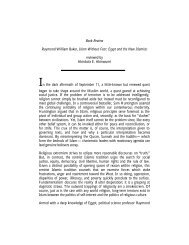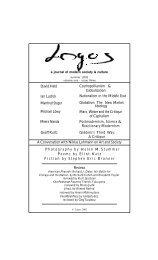Michael J. Thompson Stephen Eric Bronner Wadood Hamad - Logos
Michael J. Thompson Stephen Eric Bronner Wadood Hamad - Logos
Michael J. Thompson Stephen Eric Bronner Wadood Hamad - Logos
You also want an ePaper? Increase the reach of your titles
YUMPU automatically turns print PDFs into web optimized ePapers that Google loves.
Ali Hossaini<br />
role described by Bazin. Since ancient times surveyors have preserved the<br />
state and its social organization by defining property boundaries. Herodotus’s<br />
description of ancient Egyptian land surveyors is no less apt today.<br />
For this cause Egypt was intersected. The king moreover (so<br />
they said) divided the country among all the Egyptians by<br />
giving each an equal square parcel of land, and made this his<br />
source of revenue, appointing the payment of a yearly tax.<br />
And any man who was robbed by the river of a part of his<br />
land would come to Sesostris and declare what had befallen<br />
him; then the king would send men to look into it and<br />
measure the space by which the land was divided, so that<br />
thereafter it should pay in proportion to the tax originally<br />
imposed. From this, to my thinking, the Greeks originally<br />
learnt the art of measuring land.<br />
Like photography, surveying was invented to extend perceptual powers.<br />
Urban planners could not comprehend the expanses necessary to build cities<br />
and empires, and surveying was the first in a long series of perceptual<br />
technologies invented to create objective, accurate images of the<br />
environment. It functioned as the eyes and visual memory of the early<br />
megamachine, a state bureaucracy that created specialized labor and social<br />
hierarchy. In contrast to cave paintings or mummification, the goal of<br />
surveying and related practices is to inform, not to express aesthetic or ritual<br />
values. At the core of a survey map is data, a representation of visual space<br />
which conveys useful information.<br />
We should keep in mind that visual representations are not necessarily<br />
pictorial. Archaic survey records, or cadastres, do not contain visual<br />
representations; they are nothing more than tables of measurements which, if<br />
associated with a particular area, describe a plot of land. In form and content<br />
they resemble digital databases which exist for the same purpose. However,<br />
by 2300 BCE an interesting parallel to the evolution of digital computing<br />
occurs in Mesopotamia. Cadastres had been growing in both size and detail<br />
since their invention in the fourth millennium, and an unknown surveyor in<br />
the service of the great UR III bureaucracy introduced an innovative means<br />
to displaying geometric data: a graphic interface. We would now call this<br />
device a map. 6 Survey maps developed rapidly within Mesopotamia,<br />
becoming a means to manipulate land through urban planning. Maps were<br />
used to manage estates, design buildings and govern cities. (See Figure 4)<br />
<strong>Logos</strong> 2.3 – Summer 2003




